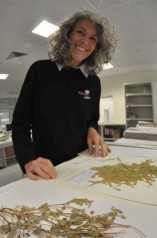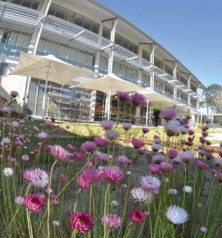The Western Australian Herbarium, part of the Department of Parks and Wildlife, is the principal research institution in Western Australia charged with documenting, describing and naming all native and naturalised plants, algae and fungi in the state. Covering around a third of Australia’s land area and half of its flora, and incorporating important biodiversity hotspots such as the Southwest and Kimberley regions, the Western Australian Herbarium has a task equal to or greater than many nations elsewhere in the world.
Research at the Herbarium centres around its collection of c. 750,000 specimens. Very much WA-focused, this is the largest and most comprehensive collection of WA plants in the world. Staff at the Herbarium maintain the scientific currency of the specimens, keep them safe, and study them to document the distribution, conservation status and characteristics of all native and naturalised WA plants.
 Around 100 new taxa of WA plants are named annually, by staff at the Herbarium and colleagues throughout Australia and the world; this is a globally remarkable rate of discovery that reflects both the hard work of the taxonomists who study our plants and the large number of taxa still remaining to be discovered and/or taxonomically resolved.
Around 100 new taxa of WA plants are named annually, by staff at the Herbarium and colleagues throughout Australia and the world; this is a globally remarkable rate of discovery that reflects both the hard work of the taxonomists who study our plants and the large number of taxa still remaining to be discovered and/or taxonomically resolved.
The Western Australian Herbarium is a partner in the ALA through the Council of Heads of Australasian Herbaria (CHAH). The Herbarium’s collection is fully databased, and all specimen records are made available through the ALA and Australia’s Virtual Herbarium (AVH). These contribute to an authoritative core of the ALA’s biodiversity records – vouchered specimen records that are continually updated and kept current in the face of new taxonomic knowledge. If your study or query involves Western Australian plants, the specimen records provided and maintained by the Western Australian Herbarium are likely to play a key role.
For more information on the Western Australian Herbarium and its ALA usage statistics, etc., see: http://collections.ala.org.au/public/show/co75.
